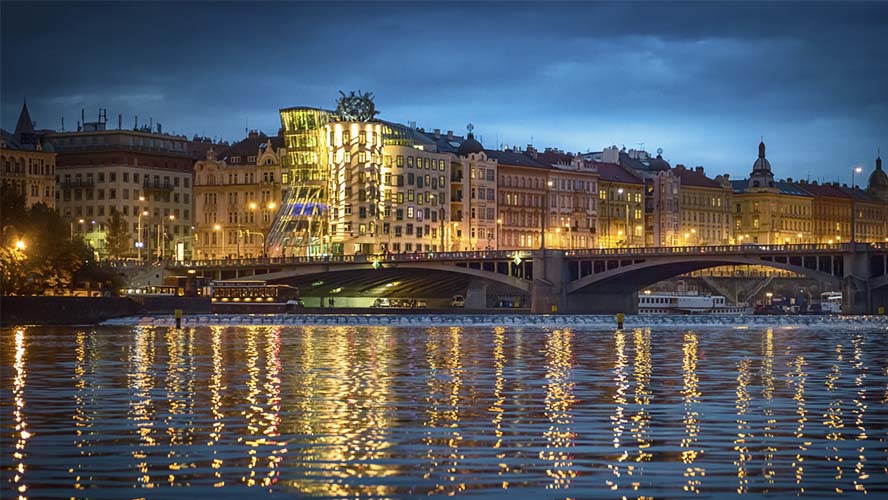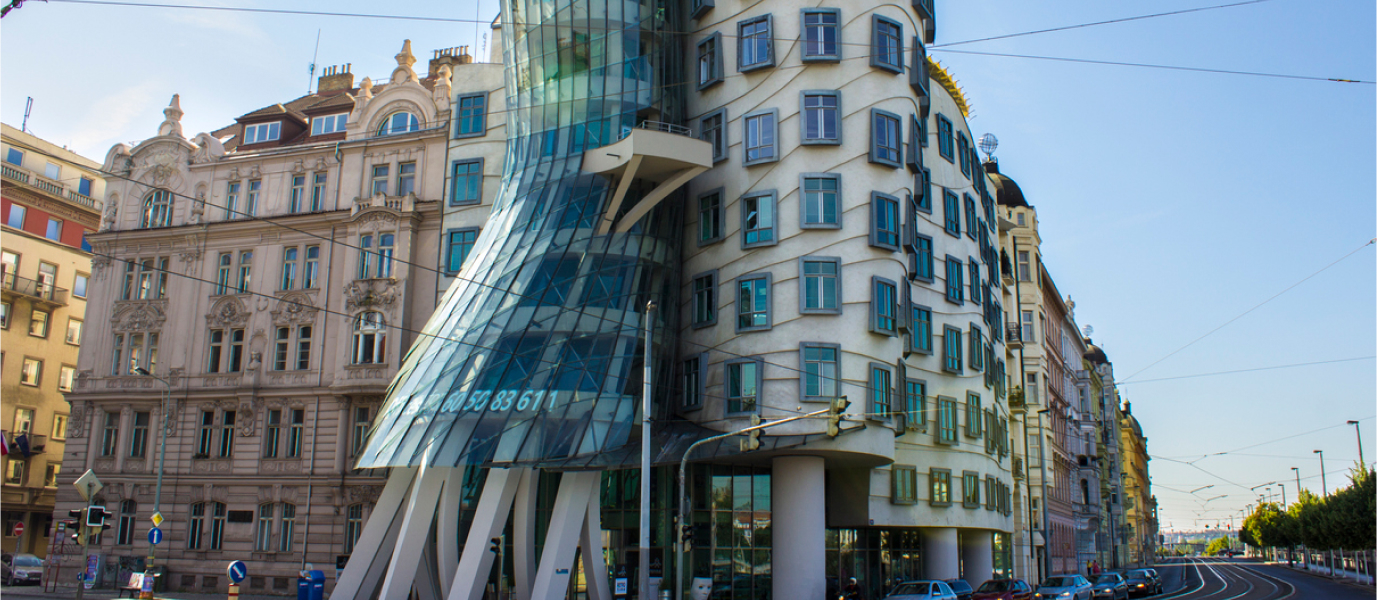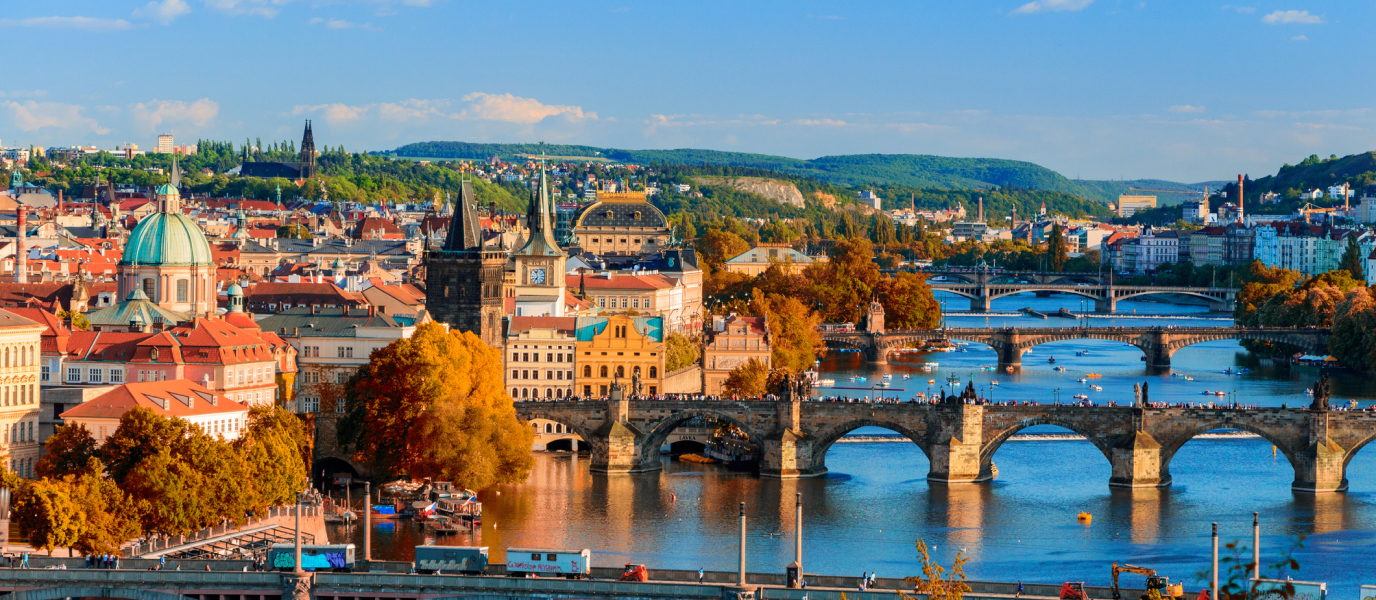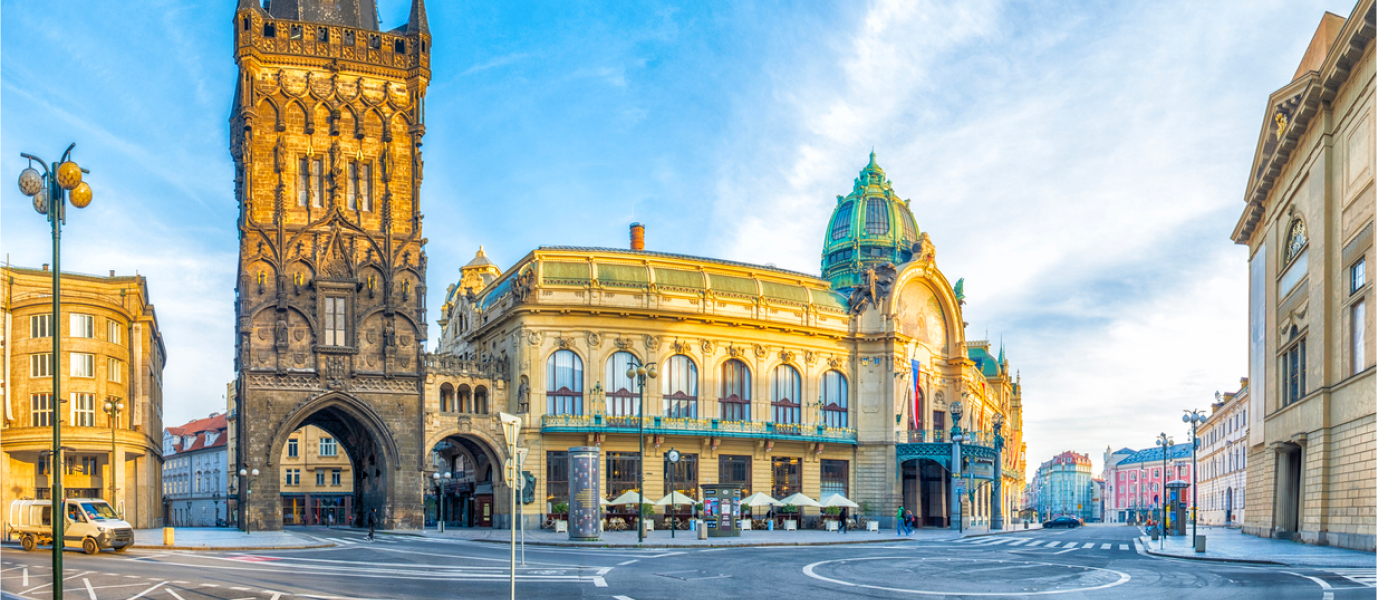Lovers of architecture have yet another reason to visit Prague. In the midst of a group of elegant neo-Classical edifices, visitors stop short in front of an original, intriguing and attractive Deconstructivist building. This is the Dancing House, created by the architects Frank Gehry and Vlado Milunić. The two towers that comprise the building give the impression that they are moving, embracing in a never-ending dance.
Located on the right-hand bank of the River Vltava, near the Karlovo Námestí metro station, the edifice is an astonishing sight. When it was built in 1996, it changed the look of the whole area. The more conservative elements of Prague society were highly critical of the project from the start. They did not consider it appropriate to disturb the harmony of the historic district. Over time, the Dancing House, with its burst of dynamism, has become a bridge between tradition and modernity.
Prague’s Dancing House, an unexpected surprise among neo-Classical buildings
If there is one building that places Prague on the map of avant-garde architecture, it is the Dancing House. Shifting, whimsical, and unexpected, it is in complete contrast to its surroundings. It is an absolute revelation among the harmonious, traditional, eighteenth- and nineteenth-century, neo-Classical edifices around it.
Early on, the building’s creator, Frank Gehry, thought of naming it “Fred and Ginger” as a tribute to the famous dancers, Fred Astaire and Ginger Rogers. That name was rejected in favour of Dancing House. But of course the people of Prague use both names indiscriminately when referring to the building.
A jewel of avant-garde architecture in Prague
This remarkable work is characterised by the contrast between the static and the dynamic. The two blocks which make up the building give the impression of a pair of dancers. The tower representing the woman seems to be performing dance steps as she leans towards her partner. The tower is of glass, and is supported by curving columns and windows that follow their undulating shapes. The tower has a unique feature in that it narrows half way up, at the point where the terrace is situated. The small group of leaning pillars holding up the tower is the entrance to the building.
The tower representing the male partner appears solid. Its protruding and recessed windows give a three-dimensional effect. The building is topped by a cupola, a typical feature of Prague buildings. Its inclusion is a gesture of affinity with the surrounding buildings. The Dancing House’s cupola is an original sculpture. It is made up of interwoven metal strips forming a semicircle.
The materials used highlight their natural colours. The green of the glass, the grey of the concrete, and the silvery appearance of the steel structure all serve to magnify the building’s strange beauty.

What to see at Prague’s Dancing House
The Dancing House has an area of over 5,000 m2, distributed over eight levels. Its official name is the Nationale-Nederlanden Building, in honour of its sponsor, an ING International Group Company. The middle floors are home to its main Prague headquarters, but because it is available for other uses, the building also has other areas which are occupied by offices.
Visitors can stay in its hotel, the Dancing House Hotel, which is located on the ground floor. At ground level, there are also various shops and a little café overlooking the River Vltava. And on the top floor is the building’s famous restaurant. A perfect place to gaze out at superb views of the Czech capital.
The history of Frank Gehry’s Dancing House
The building that previously stood on the site now occupied by the Dancing House, in the central Resslova street, was destroyed during the Second World War. The plot was acquired by the Dutch Insurance Company Nationale-Nederlanden, which planned to create a building with its own personality, which would make the company stand out. So they sought advice from Vlado Milunić, a Czech architect born in Croatia. He presented them with an interesting sketch. It was of an angular structure with a tall glass cupola, a tribute to the Russian sculptor Vladimir Tatlin.
The company welcomed the design with great enthusiasm, but in order to boost the image of the new building, they decided that they needed to bring in an internationally famous architect. Milunić contacted Frank Gehry, and the two began working together. Gehry drew on the original idea, but added elements and perspectives to further enrich the project. The pair enjoyed full creative freedom to do whatever they wished—and a generous budget.
The design was finished by 1992, and the construction work began in 1994. Two years later, the building was completed. It won awards and international recognition, but Prague’s more conservative elements were reluctant to give it credit. They referred to it as “The Drunk House”. The critics could not prevent the house from attracting an ever-increasing number of admiring tourists. Time has served to prove the Dancing House’s original and indisputable contribution to Prague’s urban geography.
Václav Havel and his defence of Prague’s dancing tower
In the face of contemporary criticism, the support of Václav Havel, the author and dramatist who eventually became the Czech Republic’s first democratic president, was to prove decisive. His name plays a vital role in the history of the Dancing House. For decades, Havel lived in a nearby Art Nouveau building designed by his grandfather. The vacant plot, following the Allied bombing in 1945, had a special significance for him. He had the idea of building a centre for culture there, a symbol of hope for the new country—following the fall of communism in 1989.
Vlado Milunić’s original project was commissioned by his friend, Václav Havel. The plans changed when Nationale-Nederlanden bought the land. But the Czech president always defended the construction of a ground-breaking building in the centre of Prague. His support helped in the stand against the critics. Nowadays, many of Prague’s citizens regard this now emblematic building as a symbol of freedom, liberation and democracy.
Frank Gehry’s impact on Prague
The great architects have achieved international renown, and the stamp of their personal style can be seen in the most important cities of the world. In the Dancing House, Frank Gehry plays with movement, and achieves a magnetic, enormously captivating effect. The image of the dancing towers is a kind of icon that leaves a permanent impression on the minds of its visitors.
The hallmark of Frank Gehry, his innovative and unconventional genius, is highly recognisable. His buildings are striking, drawing attention to the setting in which they are located. This is certainly true of the Dancing House, as well as of Bilbao’s Guggenheim Museum and his other works. They all have a similar sense of movement, fluidity and constant transformation.
Gehry, as a disciple of the Deconstruction movement, breaks all the fundamental rules of architecture. For him, buildings are works of art, sculptures. But this is not at odds with their functionality or their integration into their environment. The metal of the façades, the experimentation with volume, and the combination of geometric shapes are the hallmarks of his work. The Canadian architect’s awards include the Pritzker Prize, the highest international accolade in the field of architecture.







































































